Dave S. from Frankfurt asks, “during my service your tech was using a meter that he plugged my treadmill into. He explained everything as he was working on it, but could you go over it again?”
Certainly, Dave, we’d be happy to. Treadmill amp draws are a very important part of our preventive maintenance service as they are an indicator of overall treadmill health. I find it to be an extremely valuable tool because it involves the precision of math and data, there is absolutely no guesswork. Sure, anybody can come out and slap some lube on your machine or vacuum it out. They may even offer a tip or two about how to extend the longevity of your machine. What separates the professionals from the amateurs are performing an amp draw, and, even more importantly, knowing what to do with that information and how to interpret it.
This article does go to great depth and is somewhat technical. If you don’t feel like the hassle, this test is performed on every treadmill we work on. Contact Us and we’ll be happy to handle it for you!
In simple terms, your machine’s amp draw measures how hard your machine must work to run. Think of it like your treadmill’s blood pressure. In the same way your heart works to circulate blood through your body, a treadmill requires electricity to flow through its components. The measurement we are taking indicates how much power is flowing through your machine, therefore how hard your machine must work in order to run.
Now, how do we complete this process? To take an amp draw, we have utilized three different methods in the field. I would only recommend the first procedure for a trained professional and someone who is comfortable working around electricity. I have shocked myself doing this, as has every single other tech I have ever met. The second method is better for the home user while the third method is the absolute best. To put it another way, we only utilize the third method now, using number two in rare occurrences and using number one only when we have absolutely no other options.
Method #1: For the first four years we were in business, we used only a standard clamp meter, available at any hardware store. We do not recommend this technique for the home user as the chance of electric shock is higher than I would prefer. Only proceed with this method if you are a trained professional and are comfortable working around electricity. Set your meter to the 20 or 30A setting. With the machine OFF and unplugged, place the clamp around ONE of the power wires going to the motor control board. These are usually white and black. Once again, clamp around only one of them, ensure the clamp closes fully. Hold or place the meter in an area where it does not come into contact with any other components inside the machine while it is powered on. That step is what makes this so difficult. Plug the machine back in, turn the power switch on and proceed with your readings. They will jump around quite a bit, take an average of the numbers you see displayed. As you can see in the pictures below, exposed wiring is present making this hazardous and the meter is in a very difficult position to read.
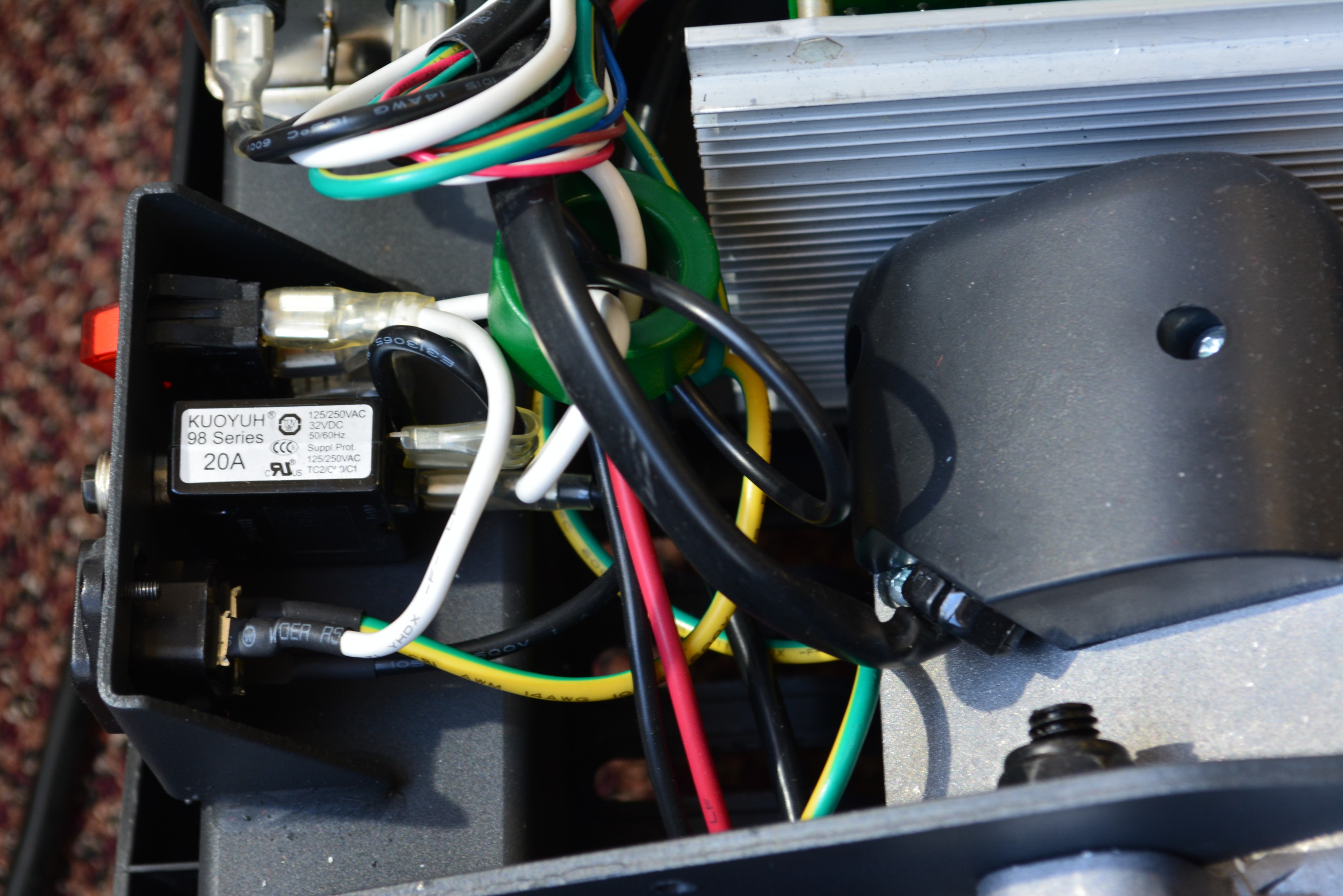
Method #2: This upgrade came about in 2011 when we first attended True Fitness certification in St. Louis. Joey Chirchirillo, a repair tech who has seen almost everything, showed our class an extension cord he had fabricated that made this infinitely easier. By removing the outermost layer of this cord and exposing the individual (still coated!) wires, he was able to then plug the machine’s power cord into this extension cord. Therefore he now had plenty of play in the cords to then hold his meter in his hand while using the machine. In the event you chose this method, any alterations made to this extension cord will void the Underwriters Laboratories (UL) certification and should only be used to test the machine for a short (under five minute) period of time. The cord must also be 12AWG or thicker, using a thinner cord than that will result in overheating and possible fire. As a reminder, the smaller the AWG number, the thicker the cord (12AWG is heavier duty than 14AWG). Our Power Extenders are properly rated for this application. Once the machine is plugged in and turned on it is MUCH easier to take these readings. They will jump around quite a bit, take an average of the numbers you see displayed.
Method #3: This upgrade was discovered during our first SportsArt certification in 2015. Because we’re nerds when it comes to this stuff, we were blown away and haven’t looked back since! Our trainer there was using a Kill-a-Watt amp meter and it made this even easier for us as technicians as well as end users. By plugging the Kill-a-Watt into the outlet, then plugging the machine into that, we saw a much smoother and accurate amp reading which was easier to record in the field after selecting the amp readout. Additionally, we discovered that when plugged into our Power Extenders we gained the best of both worlds, the flexibility of Method #2 with the smooth reading of Method #3! Full disclosure, that is an Amazon affiliate link above, by purchasing through that link we will earn a small commission, thank you for your purchase!
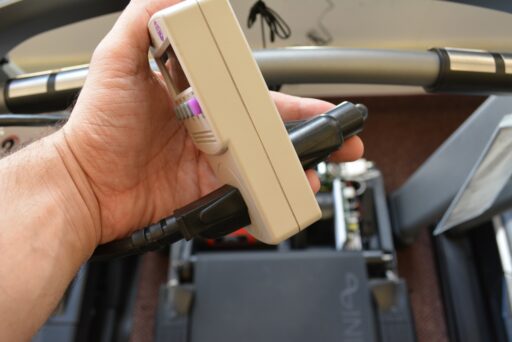
No matter which method we use, we take four readings. Prior to lubricating the machine, both loaded and unloaded, as well as loaded and unloaded after lubrication. This allows us to determine a baseline and then determine how lubrication improves the machine’s amp draw. All readings are taken at 4mph, we have found this to be an adequate speed to accurately test the machine while not being too fast than would be safe while walking and holding the cord. Unloaded measurements are taken with no one on the machine, loaded measurements are taken with a user walking on the machine at 4mph. It is important all readings are taken at the same speed.
Unloaded, a very healthy machine should be consuming no more than 2 amps. A moderately healthy machine will be reading 2-4 amps, a mediocre reading is 4-6 amps and anything over 6 amps will undoubtedly signal an issue that will require diagnosing. Loaded readings will be different depending on the weight of each user, but the general rule is that a very healthy machine should be consuming no more than 4-6 amps. A moderately healthy machine will be reading 6-8 amps, a mediocre reading is 8-10 amps and anything over 10 amps will indicate an issue that will require diagnosing. Regardless, the loaded reading should be no more than 4A more than the unloaded reading.
If your amp draw is high unloaded, there is an issue with the system as it is currently running. The issue is NOT going to be the belt and deck (at least not entirely, more on that later). A high unloaded amp draw signals an issue with the drive motor, over tensioned drive belt, bad bearings in the front and/or rear rollers, and/or an over tensioned walking belt. At this point, you will need to isolate each component to determine the issue. Check the tensions of your belts. Are they too taut? Loosen them up, see if that corrects the issue. How easily do the front and rear rollers spin, are they noisy? Do they bind up? If so, they need to be replaced, they should spin freely and quietly. Is your drive motor noisy, does it bind up? If so, the motor will need to be replaced or rebuilt.
Start at the beginning by testing the drive motor’s amp draw only and add components until everything is back together. Disengage the drive belt and test the amp draw. This will give you a reading on the drive motor only. Reinstall the drive belt, check tension and loosen the walking belt so the belt does not spin. This reading will give you the amp draw of the drive motor and front roller. Retension the walking belt, check the tension and take another reading. This will test the entire system and should be similar, if not identical, to the unloaded reading you took before. The component(s) added that resulted in a dramatic spike in amperage will be the source of your issue.
If the amp draw is within specifications while unloaded, but high when loaded, that is indicative of a high amount of friction between the belt and deck surfaces. Lube the machine, walk the lube in and retest. If your amp draw improves to the measurements outlined above, wonderful, your machine is operating as designed!

If your amp draw is still high, investigate the belt and deck surfaces. Decks should be completely smooth with a glass-like smoothness under the entire area the belt is over. Belts should be fibrous underneath, with no smooth burn-in spots. If a deck needs to be replaced the belt MUST be replaced as well. If the deck is in great condition, you may get away with just replacing the belt, make absolutely certain the deck surface is perfect prior to making that determination. Below are two examples of decks that should have been replaced long ago. These are extreme examples, once more, the deck must be smooth and free of any imperfections to not require replacement.
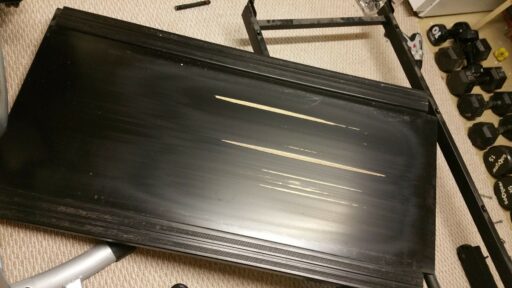

By testing your machines amp draw you will be able to accurately determine if components of your machine are in need of replacing. All too often, generally due to a lack of lubrication, we are called out to diagnose a machine with no motor movement. We usually find this is due to a damaged motor control board that overheated due to a high amp draw, caused by the high belt and deck friction which all began with inadequate lubrication. A $20 bottle of lube and basic maintenance could have prevented what has now developed into a $400-$1000+ repair. Once again, if this is more than you would prefer to tackle yourself, Contact Us and we’ll be happy to take care of it for you. Just like your car, proper maintenance is vital to extending a machine’s longevity.
Thank you again for your question Dave, we’re always happy to explain in detail the processes and techniques we utilize to keep your machines in top shape!
Special thanks to Jake Williams at 2nd Wind Exercise in Merrillville, IN for letting us use their showroom for these equipment photographs.

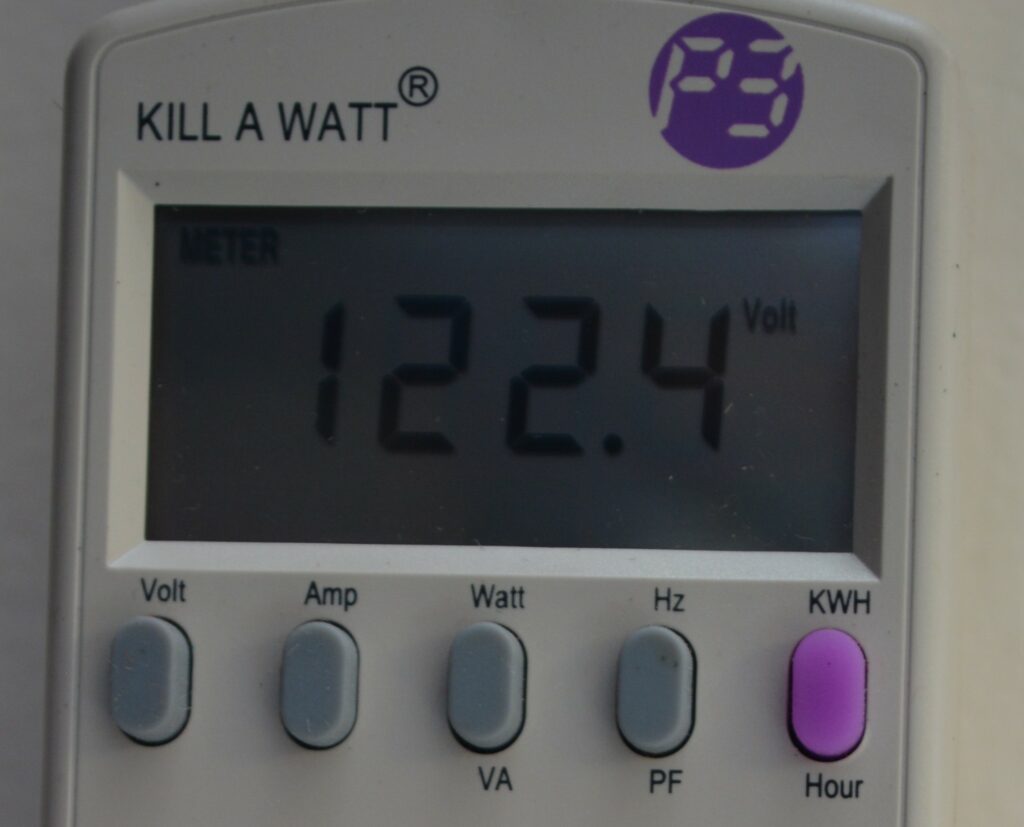
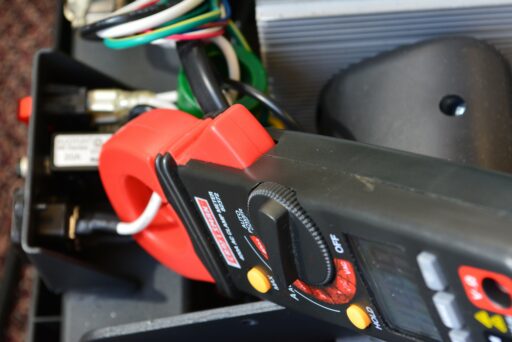
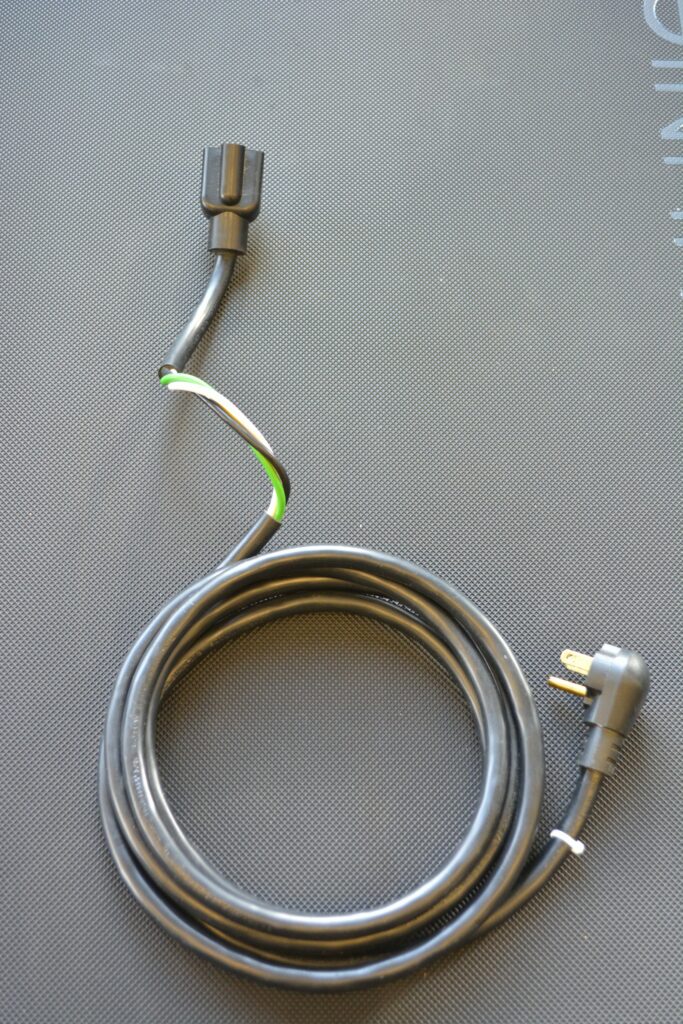
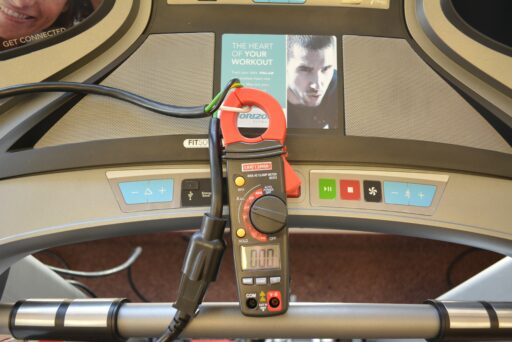
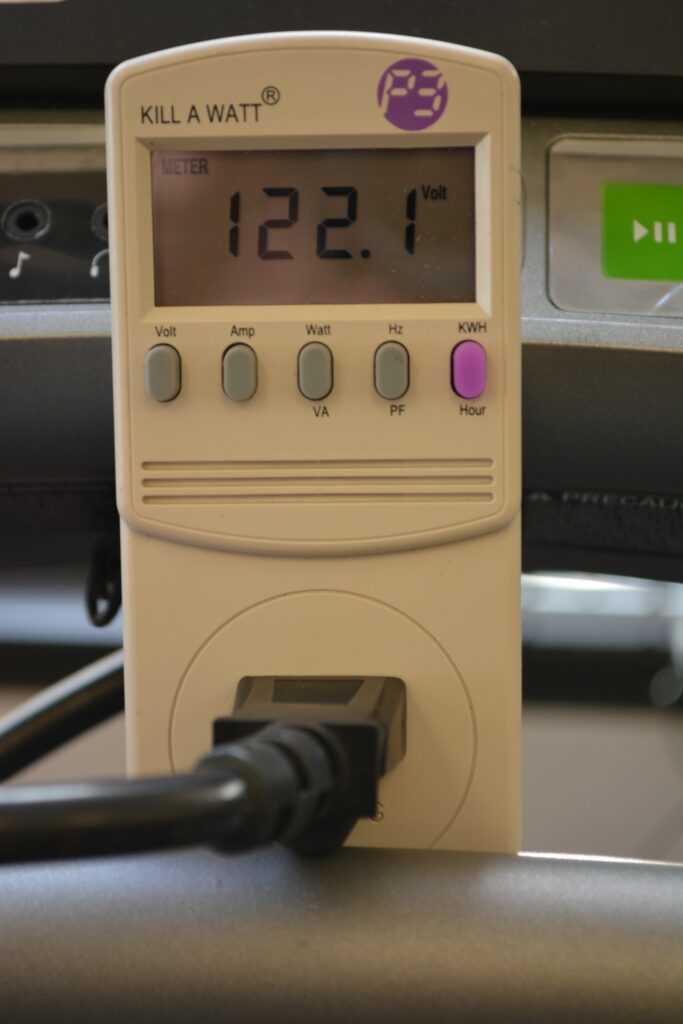
Just wanted to say THANK YOU for this very informative and timeless article. Because you shared your expertise, I will buy a gadget through your link, earning you a few cents! 🙂 BTW, it’s taut, not taught.
And I love your sense of humor!
Ahhhhh, how did I make that mistake!?! Thank you for pointing that out, that has been corrected! We’re glad you enjoyed the article, thank you for your purchase!
Thanks for this!
You’re welcome, we’re glad you found it helpful!
Hi there – I did the amp test and all was well. My reading ranged from 1.5A draw at 4mph to 3A when loaded. It only changed by about 10% between lubed and un-lubed. The issue is that the speed will go no higher than about 8mph. A this level the draw is very close to 6A. The machine (Life Fitness T9i) should reach about 12.4mph (20kph). Do you think the issue is likely to be the motor or my power supply? (Or something else!) Many thanks.
I just had a thought: – I’m on a 230V UK source, so perhaps my readings are all too high (and I should work through the other tweaks)?
Hi Duncan, thank you for your inquiry. I believe the amperage should be the same regardless of the input voltage, but don’t want to give you bad info as we’re not familiar with UK power sources. Your best bet would be to contact Life Fitness directly at 01353 665507 or uk.serviceparts@lifefitness.com Monday-Friday 8:30 a.m. – 5 p.m. GMT
This article saved me 500 bucks. Due to poor maintenance, I burned up a controller board and didn’t realize that all the issues I was having were due to friction.
I purchased a Kill-A-Watt and discovered that my amp draw was >10. A bottle of lubricant and new belt has me up and running again!
So happy to hear that Vincent, enjoy the extended life of your treadmill!
Thanks for the article! My treadmill is drawing 2.5 amps unloaded then up to 11A loaded. It was free just had to move it. Still troubleshooting. It’s been lubed, cleaned and all basic maintenance complete.
Hi Kyle, thanks for your comment! I don’t want to sound too extreme, but to prevent damage to your treadmill, you should stop using it right now. The belt will certainly need to be replaced, and the deck may need to be replaced as well. Your unloaded draw looks fine, but with an 8.5A increase, you’re in danger of blowing your motor control board. Have you checked your deck surface? it should be as smooth as glass along the entire surface. If not, replace your deck in addition to your belt. Let us know how the repair goes!
my treadmill puts out less than 1 amp DC from the motor, and motor will speed up and down but has no tork . what is wrong ?
Hi Michael, thank you for your question!
What make and model of machine you have? If the torque is low, there is likely a torque potentiometer on the motor control board that can be adjusted to increase that. As always, it’s best to check with your specific manufacturer for the proper setting. Let us know if you need help obtaining that!
Thank you so much for this article! My treadmill was 8 years old (2000 mi) and I had never lubed it (the manual said nothing about doing that). Last October, something “blew” but fortunately I had the extended warranty. They sent a new control board, but when the tech came he said the motor had blown, so I waited for the new motor and he came out again and replaced both those parts. But then when running on it, it would suddenly slow dramatically for a bit then speed back up. So they sent a new DRIVE belt and he came and replaced that. Still the same problem (now we’re many months in). Doing my own research I put lube under the belt, and still the problem. FINALLY I found this site, and bought a kill-a-watt. I was pulling 3.9A unloaded and ~9A loaded at 4 mph! I bought a new belt, and now I’m pulling 2.8A unloaded and 4.6A loaded! Your advice, replacing the walking belt, and having the kill-a-watt, were invaluable and turns out the walking belt was the problem the whole time. At least I got a new motor and control board out of it!
Now I’m taking my kill-a-watt to my friend’s house to test her treadmill (and I’m bringing treadmill lubricant too!) You may have saved her a motor and/or control board.
Hi Thomas, thank you for your comment!
THIS is exactly what our goal is in putting all this information out there, I’m happy to hear you found it beneficial and were able to help a friend as well. It sounds like it was a frustrating experience at the beginning, I’m happy you found us. Thank you again for taking the time to let us know we made a difference, we certainly appreciate it!
Ok, have a nordictrack X9i, bought used, no idea of past maintenance. It’s symptoms are after running for a while with a heavier user, slows and sometimes stops, but once user gets off the tread it speeds up and goes back to whatever speed it was set at. At the same time the led on the controller goes from fast flash to a slow flash (no pauses). I understand this is fold back mode to protect the unit from excessive load. I’m lighter than the other user, so with me I don’t experience the issue. So when your article stated that you use a killawatt meter, I remember that I have one of those. So 1.6a at no load and up to 8amps with the heavier user, and I’m a around 4.5 to 5a at 4mph. Now I ordered a belt, lubrication, and a deck repair kits that resurfaces the deck. So I believe this will fix the issue, but was wondering if the controller, which senses an overload, can over time lower it’s overload threshold due to repeatedly being overloaded (due to high friction, lack of maintenance a over long period in such a condition). It seems to me that although the heavier user gets to 8amps it seems that my overload starts faster than it should. Is there a way to test the fold back set point, and do you know how the controller determines foldback situations (heat sensor or current monitoring) probably a bit in the weeds with that but I am mostly wondering if controllers can weaken and go into this fold down mode faster (maybe a potentiometer adjustment to bring it back up. Any thoughts? Thank you in advance.
Hi Sean, great info and questions, thank you!
First off, it sounds like you’re on the right path after testing your amp draw and determining the machine will require a new belt and deck repair kit, your amp draw should drop considerably after those are replaced.
Regarding the overload threshold, the specifics of that are more within the scope of the machine’s design engineers. Anecdotally though, I can tell you that I am aware of two different overload protection circuits used on motor control boards, one triggered by a high amp draw, the other a thermal overload switch. We do also know that these can weaken over time, resulting in the machine’s overload threshold lowering after each trip, to the point where total failure does eventually occur. At that point, an MCB replacement would be necessary as these boards are generally not repairable at the component level.
Thank you again and let us know how the repair goes!
Great information, thank you. Just bought a new Famistar T600 treadmill, which I am really pleased with, but the instruction manual is crap (its made in China, which is apparent in the “translated” manual..lol). It includes a lubrication port hole, but gives no clue as to just how much lube to use. At least this will give me a more scientific way to measure my lubrication efforts. Much appreciated!
P.S. Even with the power of Google, I can’t seem to find out who really makes this treadmill. It is sold by Walmart and on Amazon. The web link mentioned in the manual (famistar-sports.com) is a half-baked website that is laughable. Any ideas?
Hi Paul, thank you for your questions!
When lubing your machine, start with about an ounce of silicone, then if more is needed, add it in half ounce increments. I would caution against using that port, as doing so will likely result in that channel gunking up and causing issues for you later down the road.
Unfortunately, we do not know who builds Famistar machines, we have seen a few of them, but as you said, there’s not much info out there about them. I do know sourcing parts can be very difficult for these hard to find brands, so make sure you keep up with your maintenance to keep it running flawlessly as long as possible!
I have a Horizon T202 treadmill that, as of writing this, had it’s running belt replaced about 6 months ago because of excess white cotton fluff coming off and overheating. The motor was replaced too (under warrenty at the time). About a month ago I started getting paranoid about my treadmill, it just didn’t feel right and slight (and I mean SLIGHT) white strands where found when I brushed my hand under the belt on the running board. I lubricated then after a few weeks, decided to get a Kill a Watt reader to measure my amps as I use it. I use my treadmill at 3.5 MPH every single day for 70 minutes a day.
For as long as I had the amp meter my treadmill fully loaded (me walking on it) was drawing about 5.5 Amps spiking at low 6, and rarely dipping to the 4.8 range at times. Today I noticed it was staying at the moderate to high 6 range and it was close to three months so I lubricated. I dont know if it made things worse? I just finished my daily walk and it was at high 5.8 to mid to high 6 and at times 6.7 and twice it spiked to 7.5.
I lubricate about once every 3 months and again, use my treadmill every day at 3.5MPH for 70 minutes a day.
Am I jumping at shadows? Or is there something wrong now. I have been paranoid ever since my first belt failed on me and this is making my fears worse.
Hi Mike, great question, and great info, thank you! I have a couple of questions that will help me point you in the right direction:
1. What is your unloaded amp draw at the same speed of 3.5mph?
2. When lubing your machine every three months, how much lube are you applying at a time?
3. If you feel the top of the deck surface under the walking belt, what does the deck feel like? Is it entirely smooth? Can you feel any lube on the surface of the deck?
Let me know and I’ll be back to you ASAP!
1) unloaded amp at 3.5 MPH about 1.5 to 2.4 ish
2) Half the bottle of the oil it recommends (it even comes in the bottle style the original oil that came with my treadmill did). Going off the measurement on the bottle itself, about 2.25 ml. Often I do the whole deck with this, but the last time, I focused mostly on the area of the deck I walk on.
3) the deck feels totally flat (so I dont think there are cracks or splits). It feels somewhat smooth but it does not feel as smooth and/or almost waxy like the areas that I dont walk on does. Sort of worn I guess. There is SOME oil feeling, but I did recently oil it. Even then it is slight as if the belt scrapped of most of it and I dont know if this is entirely right but the residue feels, slightly sticky or viscous? Not as oily as I think it should. Before oiling, it felt close to if not dry, smooth but a worn sort of smooth. Sorry, it’s hard for me to fully explain.
Is it possible that, given how often I use it, I didn’t lubricate enough? Even after the recommended 3 months the owners manual said? If the deck is sufficiently worn down, will lubricating help or make it worse. Again, after I did that the amps where still high if not at times even an amp higher.
Perfect, thank you!
Your amp draw delta, the difference between your unloaded and loaded readings, is over 4A, which is just over the threshold for action needing to be taken. Can you please confirm you’re applying 2.25ml of lube at a time? If so, that’s not going to be enough to do much, most lubricants should be applied in one-ounce increments, usually every six months to a year, depending on use.
If your deck is feeling worn, take a closer look. If you’re comfortable with it, loosen your walking belt to then lift it above the deck so you can visually inspect your deck. The surface should be perfectly smooth, if it isn’t, it’s similar to running your new belt over sandpaper, and your new belt will wear prematurely. When running your fingers along the top of your deck, it should feel oily, your fingers should have visible lube on them after you run them across the deck.
At this point, I’d check that deck surface and ensure that the machine is adequately lubed. The cotton underlayment of the walking belt will absorb the lubricant, so you may need to apply lube more than once, just be careful not to over lubricate it, that makes a huge mess. What I would recommend is running your fingers along the deck prior to your workout. If not oily enough, add half an ounce of lube. Walk that lube into the belt during your workout, and continue this process prior to every workout until you consistently find an oily film on the deck surface.
That being said though, proceed with that plan only if your deck is perfectly smooth. If that deck is worn, stop using your machine immediately and replace the deck. There is a chance you may need a new belt as well, so if you are able it certainly would not hurt to replace the walking belt and deck together.
Let us know what you find and don’t hesitate to ask if you have any other questions!
Hi, sorry, I miss-read the decimal place on the bottle, I am using 22.5 ml.
According to conversion it is about 30ml to equal an ounce.
Yeah the deck feels smooth, no grooves or gouges or damage, but it’s not slick or waxy like areas that I dont walk on are.
Also judging by how often I use it, am I just overworking it too maybe? Leading to early wear?
Glad to hear it, 22.5ml is a lot better than 2.25ml!
If the deck is not smooth, it should likely be replaced. It’s tough to say from the other end of a computer screen, you may want to have an authorized servicer come out to take a look to make an informed decision.
Roughly 4 miles per day would not be overworking it, but it will need more frequent lubrication. Stick with checking it before each workout and lubing when necessary to extend your machines life as much as possible.
Let us know if we can help in any other way!
Thank you for this informative article. I have a similar problem that I’d like your opinion on. I have a Lifespan TR1000SL treadmill that consistently is shutting down after 35-45 minutes of use and displaying an E1 code. This unit was given to me, so I have no background on. It works well with the exception of the shut down issue.
I’ve taken the motor cover off after shut down and the motor is so hot, you cannot keep your hand on it. Amp draw is as follows: 1.3 unloaded at 3 mph, 8.0 loaded at 3 mph. I’ve lubed the belt and it actually seemed to make it worse…shut down at 30 mins. I have the belt tensioned just to the point that it doesn’t slip. I’ve checked the rollers and the bearings are smooth. Drive belt tension appears good. Inspection of the deck revealed a smooth glassy surface with no imperfections. One thing of note…both rollers were covered with a gray matted material that was slightly tacky. It washed off easily. The underside of the belt looks fine, but I can tell the difference in slickness when gliding my finger over the edge of the belt which is whiter and slippery versus the middle of the belt which is darker and feels less slick. It appears I need a new belt..but I don’t want to just throw parts at it. Thoughts? Thanks SO much!!
Hello Charles, thank you for your comment!
With amp draws through the roof, your walking belt will definitely need to be replaced, and we highly recommend that be done prior to using your machine again. Continual overheating will cause your motor control board (MCB) to blow, making this a much more costly repair.
As always, there is no replacement for a professional, in-person diagnosis to fully diagnose all components of your machine, but this is where we would start!
I’m having a problem and no one within a 2hr radius that can look at my treadmill. My husband lubed our belt as it was starting to get warm when walking on it. Well it worked well for about 2 weeks and then started cutting off while walking. We noticed the belt is hot at this point. You can walk with no shoes and it never cuts off but of course that’s unrealistic when exercising. He checked the Amp draw and it was 1.6 unloaded and 6 loaded. What might be the issue? Again it’s well lubed and the belt is not worn as it’s just over a year old so no warranty either.
The easiest method is to measure the current directly with a multimeter or clamp meter. By putting the leads across the power terminals of the motor, you may connect the meter in series with it to measure the amperage.
Hi Sabrina, thank you for your question!
If the machine is cutting out, that is likely due to an amp overload, and you should stop using the machine immediately to prevent injury, or further damage. With an amp draw delta of 4.4, as well as the amount of heat present, first check to see if the belt needs more lube. If not, we would recommend replacing your walking belt (as well as inspecting your deck) ASAP.
Thank you James, happy to hear that method works well for you!